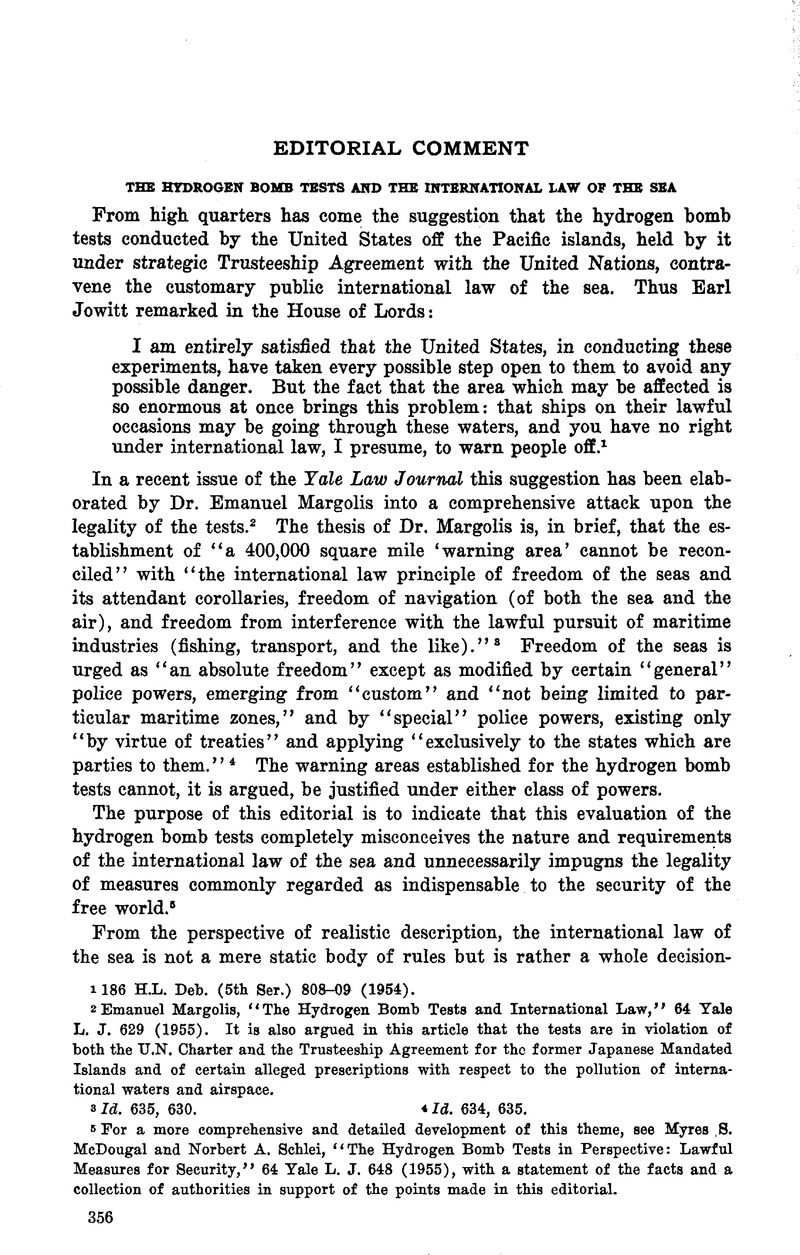Published online by Cambridge University Press: 30 March 2017

1 186 H.L. Deb. (5th Ser.) 808–09 (1954).
2 Margolis, Emanuel, “The Hydrogen Bomb Tests and International Law,” 64 Yale L. J. 629 (1955).CrossRefGoogle Scholar It is also argued in this article that the tests are in violation of both the TJ.N. Charter and the Trusteeship Agreement for the former Japanese Mandated Islands and of certain alleged prescriptions with respect to the pollution of international waters and airspace.
3 Id. 635, 630.
4 Id. 634, 635.
5 For a more comprehensive and detailed development of this theme, see McDougal, Myres S. and Schlei, Norbert A., “The Hydrogen Bomb Tests in Perspective: Lawful Measures for Security,” 64 Yale L. J. 648 (1955)CrossRefGoogle Scholar, with a statement of the facts and a collection of authorities in support of the points made in this editorial.
6 Schiffer, , The Legal Community of Mankind 264 (1954)Google Scholar, presenting the views of Georges Seelle.
7 It is not of course the unilateral claims but rather the reciprocal tolerances of the external decision-makers which create the expectations of pattern and uniformity in decision, of practice in accord with rule, commonly regarded as law.
The great bulk of claims to authority and control upon the high seas are honored and protected, it may be emphasized, not by explicit bilateral or multilateral agreement, but by this process of mutual tolerance. The decision-makers of the world community have never regarded themselves as confined within any such categorization as that of “general” and “special” powers propounded by Dr. Margolis.
8 Excellent statements of this positive policy of promoting, rather than restricting, use may be found in Lauterpacht, “Sovereignty over Submarine Areas,” 27 Brit. Y.B. Int. L. 376, 378, 407Google Scholar et seq. (1950), and in U.N. Secretariat, Begime of the High Seas, U.N. Doc. No. A/CN.4/32, at 10, 12 (1950).
9 The test is well stated in Smith, The Law and Custom of the Sea 20 (1950). See also Jessup, Law of Territorial Waters 91–101 and passim (1927); Masterson, , Jurisdiction in Marginal Seas xiii–xviii, 375 et seq . (1929)Google Scholar; Dickinson, , “Jurisdiction at the Maritime Frontier,” 40 Harv. L. Rev. 1 (1940).CrossRefGoogle Scholar
10 Stat. I.C.J., Art. 38. A decision-maker is thus not confined, in determination of lawfulness, to explicit agreements or inferences from prior customary behavior, but may draw creatively upon a great variety of principles, precedents, analogies, and considerations of fairness. An excellent example of this process by which external decision-makers appraise unilateral claims is offered by the Anglo-Norwegian Fisheries Case, Judgment of Dec. 18, 1951, [1951] I.C.J. Rep. 116. In this case Norway asserted claims which could not be justified by reference to either explicit agreement or widely accepted custom, and which had been protested by other nation states, but by drawing upon all relevant sources of policy and a great variety of considerations in the context, the Court concluded that Norway’s claims were lawful. See Waldock, , “The Anglo-Norwegian Fisheries Case,” 28 Brit. Y.B. Int. L. 114 (1951)Google Scholar.
11 The items cited in note 8 supra review this history, with references. See Boggs, , “National Claims in Adjacent Seas,” 41 Geographical Rev. 185 (1951)CrossRefGoogle Scholar, with tabular presentation.
12 For references, see Martial, , “State Control of the Air Space over the Territorial Sea and the Contiguous Zone,” 30 Can. Bar Rev. 245 (1952)Google Scholar, and Masterson, , “The Hemisphere Zone of Security and the Law,” 26 A.B.A.J. 860 (1940)Google Scholar.
13 Higgins and Colombos, International Law of the Sea (2d ed. Colombos 1951) Chs. 14, 16–18, 20.
14 Unless one regards as of sufficiently close analogy the long-standing practice, apparently never questioned, of establishing the relatively smaller warning zones required for conducting naval maneuvers and other peacetime defensive activities with safety.